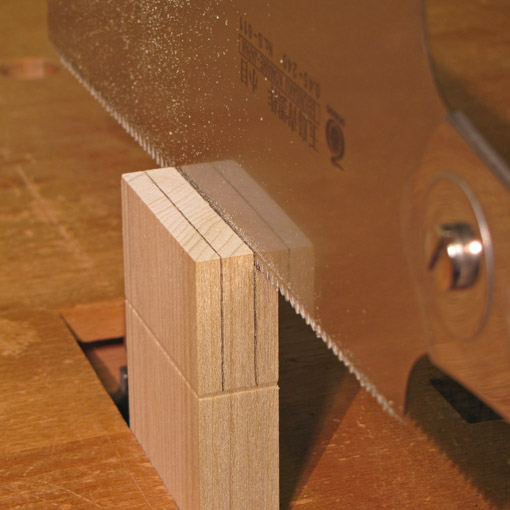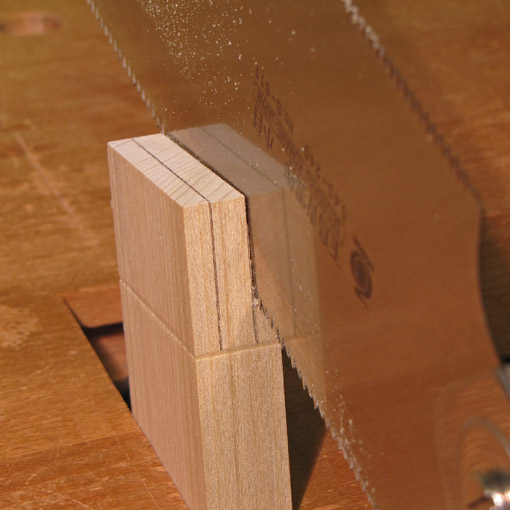
Tip #4: Since you can only watch one line at a time, see one line while you feel the other.
For most sawing, you are viewing a single line while using a physical registration for the other axis of the saw. I will explain.
In ripping with a handsaw, you follow the line with your eyes and the saw after establishing and then maintaining the saw at 90 degrees to the wood surface. When sawing a dovetail tail, most woodworkers start the saw along the end-grain line, establish that 90 degree relationship, and then view and follow the line down the wood.
In both cases your eyes track one line as you feel the angle you initially established with the saw by using an estimate of position (ripping with the handsaw) or another line (dovetailing). In dovetailing, you can use both lines to position the saw before you start. You can also use peripheral vision to sense the saw’s squareness to the length of the bench or a wall behind it. Yet when you are actually sawing, that initial line on the end grain is really only there to start you out. It is not necessary to continue to watch the remnant of it as you cut down the face-grain line, as long as you maintain a true stroke in one plane.
In any moment, the eyes can only watch one detail. Yes, there is peripheral vision, but even a small distance away from the spot you are “looking at” (technically, on which you are aligning the very tiny center of your retina, the foveal center), the vision is not very clear – not clear enough to follow a fine line. So if you attempt to follow two lines at once, the best you can do is to quickly jump your eyes back and forth from one line to another, and this must be done in the rhythm of your sawing stroke. The feeling one might have of actually accurately viewing two lines at the same time is an illusion.
Now, consider sawing a tenon. For some reason, it is often recommended to follow the end-grain line on top of the wood at the same time as you follow the line down the side of the wood. In other words, to saw a triangle into the wood in one motion.
In this method, the two contact points of the teeth biting into the wood grow further apart from each other as the cut proceeds. Yes, by aligning your eye, the two lines could be viewed as one, but the saw teeth are biting at two ends. Again, the best you can do is actually jump the eyes from one spot to the other.
The better way, in my opinion, is to cut the single end grain line first. The eyes follow one line and the saw is held vertical by feel. I like to establish the cut first at the near end, then the far end, work each cut toward the middle, then cut the full width as the saw is established in a kerf. I advance just until the teeth are buried, as seen in the top photo.
[By the way, if the saw blade is shiny, the vertical orientation of the saw can be checked before starting by observing the continuous straight line created by the top corner edge of the wood and its reflection in the blade. See the photos. I don’t find this necessary, but it is a neat trick to know.]
Then I saw the line down the side of the wood, only watching that line. The saw does not bite further in at the far end of the wood, only on the near side, going down the line. The initial kerf established on the end grain is the “line” I feel, as I watch the line down the side. See the photo below:

I proceed similarly on the opposite side. Next, the final remaining internal triangle of wood gets cut almost entirely by feel since there are kerfs all around it. At this point, I do not want to redirect the saw; I’m just going with the flow, by feel, with what has already been accurately established.
A similar sequence is useful in accurately crosscutting beams by hand, such as a 4×4.
Seeing and feeling work together to make accurate sawing.
Next: attitude matters.


It’s like throwing a ball or swinging a golf club, if you get too self-conscious about every part -try to control every aspect, you will not do nearly as well as if you leave it to your more autonomic functions to make what your eyes see and brain desires. Trust your muscles and strangely enough you get better control by trying to exert less. There are some aids – stuff to keep in mind in the act – that can help get yourself out of the way such as remembering to not put a death grip on the saw, let the saw do the work, use the whole blade and visualize moving it along an infinite straight line, etc. Cool posts!
Thanks for the contribution, Sean.
Practice, then trust and let it flow.
Rob